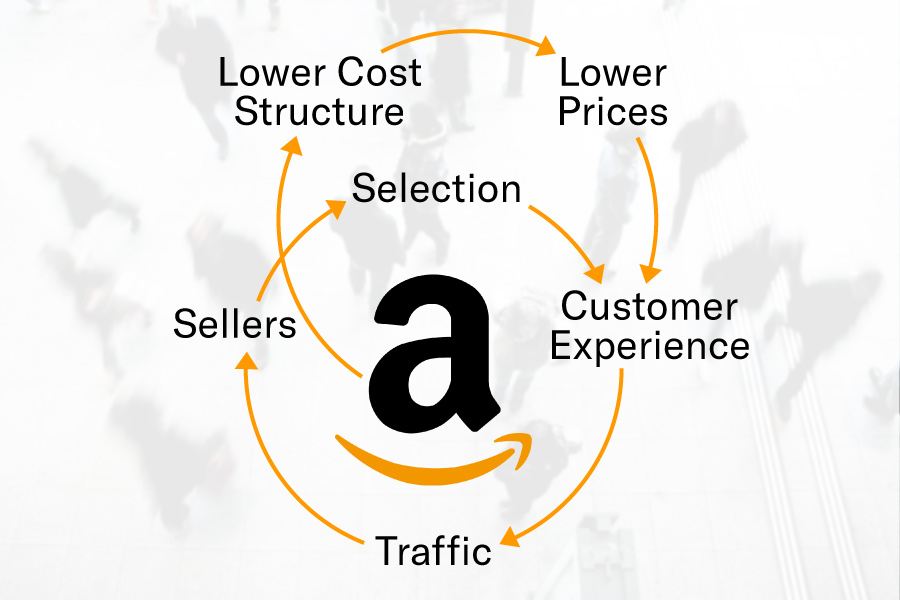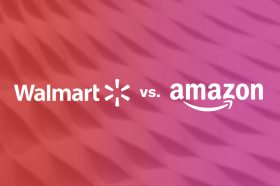Resources - Blog
The Amazon Flywheel Explained: Learn From Bezos’ Business Strategy

Stay on top of the latest e-commerce and marketplace trends.
If there is one founding principle that Amazon has remained ruthlessly committed to since its genesis, it is customer centricity —“start[ing] with the customer and work[ing] backward.” While undergoing the transformation from an online bookstore to a marketplace that offers hundreds of millions of products, Amazon has relied on its own bespoke version of a business framework that was first coined by strategist Jim Collins in 2001, known as the “flywheel effect,” in order to preserve this customer-first mindset.
By definition, a flywheel is a heavy revolving wheel that is used in a machine to increase momentum and therefore provide greater stability to the machine. Given its weight, the flywheel is difficult to push from a standstill, but once it starts moving it gradually builds momentum, which eventually enables the wheel to turn by itself and create even more of its own momentum through a self-reinforcing loop.
What does this strategy mean for businesses? The “flywheel effect,” which Amazon also refers to as the “virtuous cycle,” represents a tangible way to generate traffic to the platform. You can also improve sales rank and increase conversions to your Amazon product listings by using an AI-driven advertising optimization solution.
Fuel the Amazon Flywheel With 30 Days Free of "AI-First" Technology
Stay on top of the latest e-commerce and marketplace trends.
The Amazon Flywheel Explained
In “The Everything Store: Jeff Bezos and the Age of Amazon,” journalist Brad Stone explains that the “flywheel effect” in the company’s early stages worked like this: “Lower prices led to more customer visits. More customers increased the volume of sales and attracted more commission-paying third-party sellers to the site. That allowed Amazon to get more out of fixed costs like the fulfillment centers and the servers needed to run the website. This greater efficiency then enabled it to lower prices further. Feed any part of this flywheel, they reasoned, and it should accelerate the loop.”
Essentially, the Amazon flywheel model is centered around price value. The lower and more competitive the prices are, the more appealing the products are to prospective customers, propelling more third-party sellers and brands to want to sell on the marketplace. This influx of stakeholders increases Amazon’s vast and diverse product selection — which acts as a competitive differentiator against competitive marketplaces — and continues to drive down costs, further fostering increased customer engagement and conversion.
With the growth that accompanies a rich customer experience comes the ability to lower cost structures and simultaneously offer customers lower prices and reinvest capital into new initiatives, which for Amazon includes continuously optimizing its Prime services, for example.
Applying the Flywheel Model to Your Business
Every improvement you make to your own version of the flywheel business model will help accelerate your growth cycle and help you achieve your key business objectives for the year. Here are a few ways you can apply the principles of the Amazon flywheel concept to your own brands:
- Keep the customer experience at the core of everything you do. Familiarize yourself with the compliance regulations and Terms of Service for each marketplace and channel you operate on to ensure that you maintain healthy account standings and customer performance metrics.
- Experiment, experiment, experiment. Try out new initiatives, such as expanded advertising offerings, that will help sustain and drive momentum to your growth cycle.
- Regularly monitor your catalog performance — know your top-selling products, underperforming SKUs, end-of-life inventory that should be liquidated, and so on. You want to constantly provide value through your selection and a big part of that is understanding your products’ life cycles and performance potential and establishing a SKU-specific strategy for pricing and advertising.
- Apply an SEO lens to your product detail pages. Make sure your product specs, keywords, descriptions, titles, and bullet points are carefully crafted, easy to digest, and engaging, answering any potential questions customers may have about the product at hand. When your sales increase on a platform like Amazon, your organic rankings can also benefit, which can, in turn, drive incremental momentum through greater demand and higher sales velocity.
- Implement reputation management tactics to promote customer loyalty, advocacy, and social proof. All of these factors can help generate positive reviews, which can also indirectly aid your rankings and overall sales figures.
While fueling the Amazon flywheel model to the point that it moves entirely on its own is not an overnight process, it is one that should be carefully examined based on what you know works for your business, your unique performance indicators, and strategic objectives. Each optimization you make to improve your business can influence your flywheel, so it remains your responsibility to regularly find new avenues to keep the flywheel in motion.
Learn what Feedvisor can do for your business.
When you partner with Feedvisor, you automatically receive access to our true, AI-driven technology and hands-on team of e-commerce experts. Contact one of our team members today to learn more about our end-to-end solution for brands and large sellers on Amazon, Walmart, and e-marketplaces.




